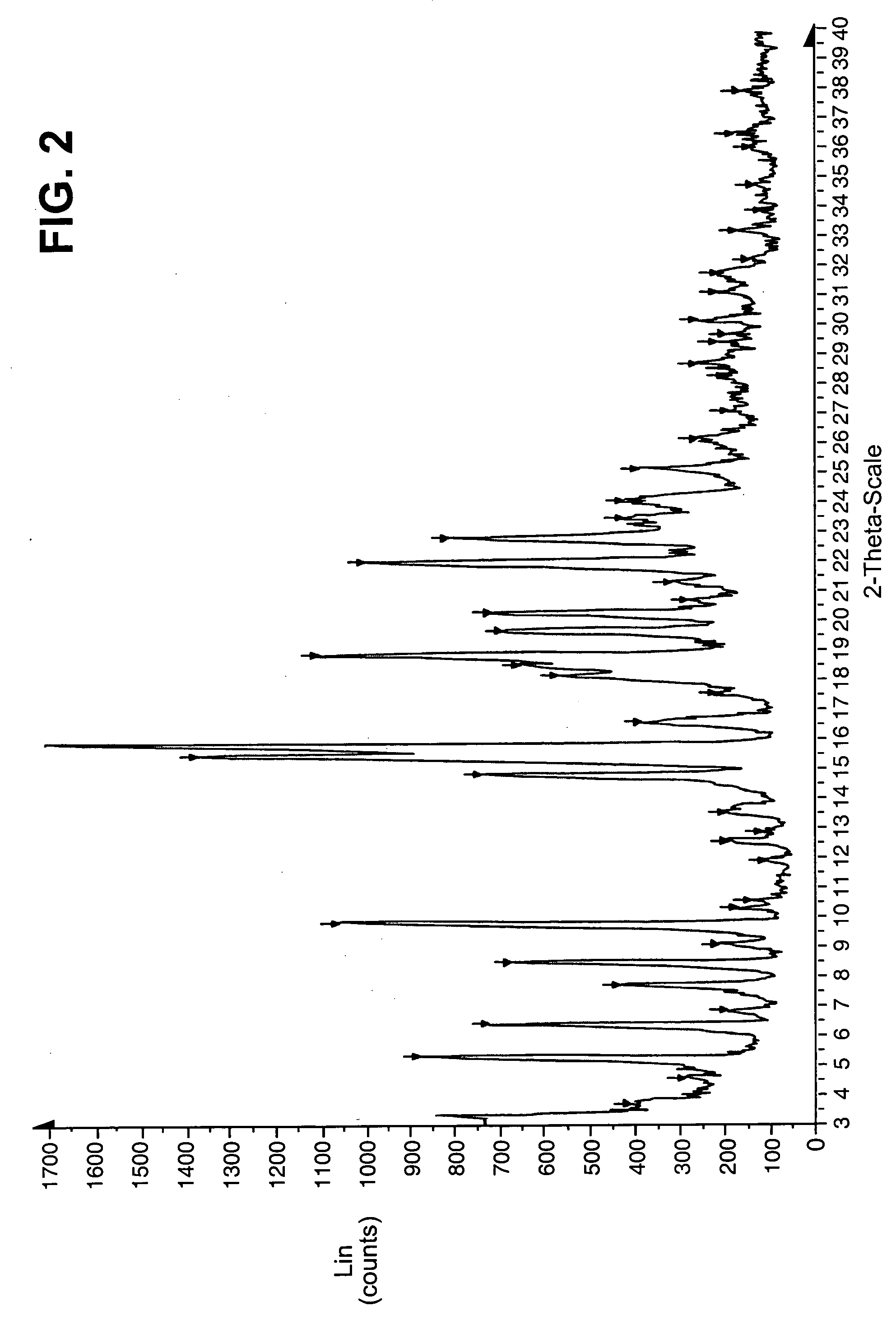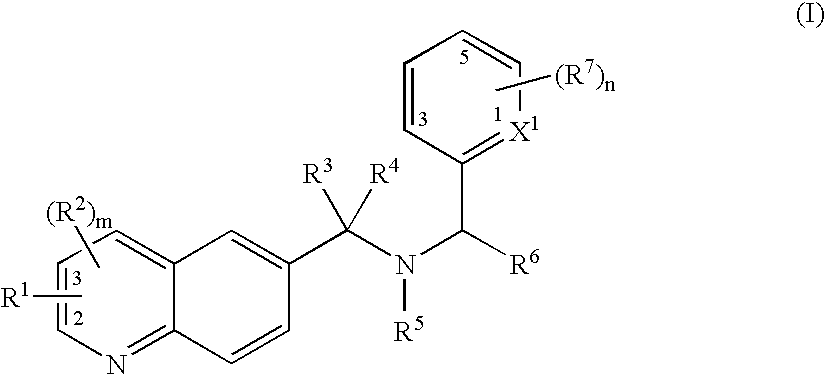Substituted quinoline compounds
a technology of quinoline and compound, which is applied in the field of substitution of quinoline compounds, can solve the problems of affecting the quality of life of people, social discrimination, and reducing physical endurance, and achieves the effects of reducing serum triglycerides, inhibiting intestinal, and reducing triglycerid
- Summary
- Abstract
- Description
- Claims
- Application Information
AI Technical Summary
Benefits of technology
Problems solved by technology
Method used
Image
Examples
example 1
(S)-2-[(4′-Trifluoromethyl-bi phenyl-2-carbonyl)-amino]-quinoline-6-carboxylic acid (Dentylcarbamoyl-phenyl-methyl)-amide
(a) Preparation of Intermediate (S)-2-Amino-N-pentyl-2-phenyl-acetamide hydrochloride
[0373]
[0374] PyBrOP (2.2 g, 4.78 mM), and N-Boc-phenylglycine (H, 1.2 g, 4.78 mM) were taken up in CH2Cl2 (25 mL) and cooled to 0° C. N-Amylamine was added and the resulting mixture was treated with diisopropylethylamine (2.5 mL, 14.3 mM). The mixture was allowed to warm to room temperature and was stirred at this temperature for 2 h. The mixture was diluted with EtOAc and washed with 1N HCl, water and brine. The organic fraction was dried (Na2SO4), filtered and concentrated. The product was purified by column chromatography eluting with 1:1 EtOAc / hexanes to give 1.19 g, of (S)-2-amino-N-pentyl-2-phenyl-acetamide hydrochloride.
[0375] The product above was taken up in 5 volumes of 4N HCl in dioxane and stirred at room temperature for 30 minutes. The solution was concentrated to ...
example 59
Preparation of (S)-4′-Trifluoromethyl-biphenyl-2-carboxylic acid (6-{[(diethylcarbamoyl-phenyl-methyl)-amino]-methyl}-quinolin-2-yl)-amide
(a) Preparation of Intermediate 4′-Trifluoromethyl-biphenyl-2-carboxylic acid (6-formyl-quinolin-2-yl)-amide
[0403]
[0404] To a solution of the ester (F-1a3, 1.04 g, 2.74 mM) in THF (10 mL) at 0° C. was added dropwise a solution of DIBAL (1.0 M in THF, 8 mL). The mixture was allowed to slowly warm to room temperature and was stirred at that temperature for 12H. The reaction was quenched with aqueous NaHCO3 and the mixture was extracted 3 times with EtOAc. The combined EtOAc fractions were washed with brine and dried (Na2SO4). The mixture was filtered and concentrated to provide the corresponding alcohol as a white solid (0.93 g). The alcohol was used without further purification.
[0405] The alcohol product (0.772 g, 1.83 mM) from the above reaction was dissolved in CH2Cl2 and Dess-Martin periodinane (0.67 g, 1.83 mM). The mixture was stirred at ro...
example 64
Preparation of (S)-4′-Trifluoromethyl-biphenyl-2-carboxylic acid (6-{[(diethylcarbamoyl-phenyl)-methyl-amino]-methyl)-quinolin-2-yl)-amide
[0410]
[0411] To a solution of the amine (0.1 mM) in CHCl3 (2 mL) was added formic acid (0.15 mM) and aqueous formaldehyde (0.3 mM) and the mixture was heated to 60° C. for 12 h. After cooling to room temperature the mixture was diluted with ethyl acetate and washed with aqueous NAHCO3 and brine, dried (MgSO4), filtered and concentrated to provide the title compound. HPLC retention time, 2.46 min; ESMS (m+1), 625; calc. Mw, 624.
[0412] The compounds in Table 3 were prepared from appropriate starting materials using procedures analogous to those for the synthesis of the compound of Example 55.
TABLE 3HPLCReten-Calc.Ex.tionESMSMol.No.Compound Nametime(m + 1)Wgt.65(S)-4′-trifluoromethyl-biphenyl-2-2.62639638carboxylic acid[6-({[(butyl-methyl-carbamoyl)-phenyl-methyl]-methyl-amino}-methyl)-quinolin-2-yl]-amide664′-trifluoromethyl-biphenyl-2-2.7967367...
PUM
| Property | Measurement | Unit |
|---|---|---|
| temperature | aaaaa | aaaaa |
| solubility | aaaaa | aaaaa |
| w/w | aaaaa | aaaaa |
Abstract
Description
Claims
Application Information
 Login to View More
Login to View More - R&D
- Intellectual Property
- Life Sciences
- Materials
- Tech Scout
- Unparalleled Data Quality
- Higher Quality Content
- 60% Fewer Hallucinations
Browse by: Latest US Patents, China's latest patents, Technical Efficacy Thesaurus, Application Domain, Technology Topic, Popular Technical Reports.
© 2025 PatSnap. All rights reserved.Legal|Privacy policy|Modern Slavery Act Transparency Statement|Sitemap|About US| Contact US: help@patsnap.com



